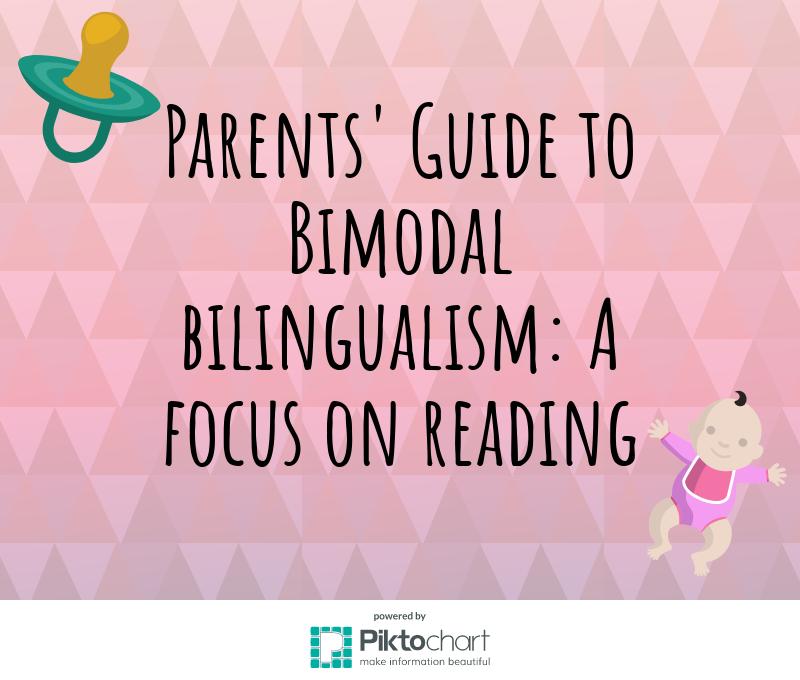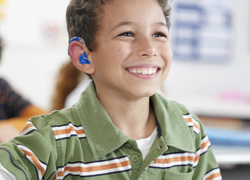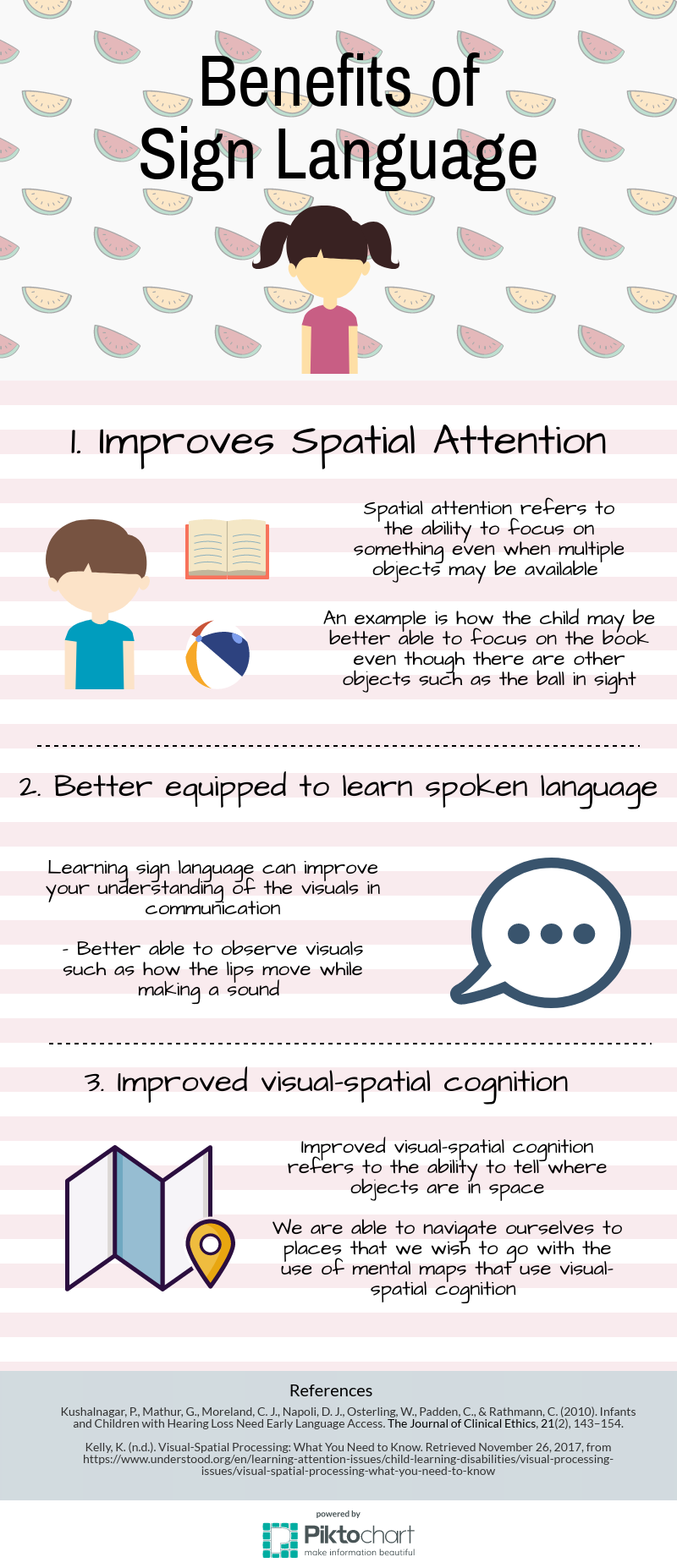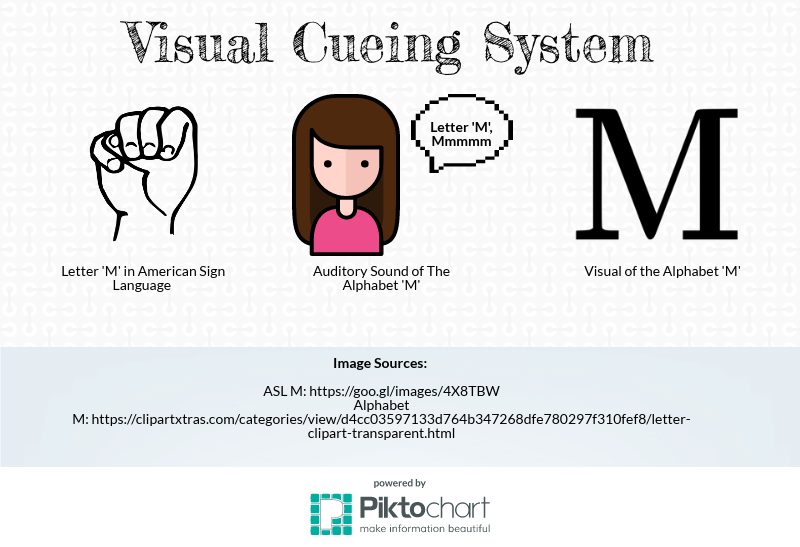Note To Parents
As a parent to a deaf child, I am sure that there will be many worries on the top of your head, Many parents worry if their child would still be able to acquire spoken language even after they give their child an Assistive Listening Device (ALD). On top of that, one of the biggest milestones of children is learning how to speak and read and this will no doubt be one of the top worries. In deaf children, this milestone may be more challenging for them to achieve. This booklet will provide information on bimodal bilingualism and the importance of sign language acquisition. This booklet will have a specific focus on reading strategies that parents can use with their child. I hope to dispel some of the worries that parents may have with the information presented.
This booklet will focus on children that have or are planning to obtain ALDs such as cochlear implants or hearing aids. It was decided that this booklet will focus on the abovementioned demographic as addressing other segments of the demographic such as children with no ALDs would unfortunately be too vast for this booklet to cover!
Section 1: Bimodal Bilingualism in Deaf Children
Question: What is Bimodal Bilingualism?
Bimodal Bilingualism refers to individuals that are fluent in two languages that are of different ways to express language, where one language can be expressed in an auditory fashion, while the other can be expressed in using motion[1]. The former language would refer to our typical understanding of language such as English, where we speak and write. The latter language would be American Sign Language, where speakers use hand motions and facial expressions to communicate. This is typically seen in deaf children that initially acquire sign language and a spoken language afterwards.
As this booklet will be focusing on reading strategies, it is important to acknowledge that teaching your child how to read in English or your native tongue would be considered as teaching your child a new language altogether! Even though many parents may worry that their child is not able to acquire a second language due to their child’s deafness, there are in fact many deaf children that are bilingual in sign language and another spoken language. Teaching your child how to read from an early stage would be beneficial for them as reading and speech production would be one of the biggest challenges that your child may face in second language acquisition.
Section 2: Assistive Listening Devices
Question: Can my child with an ALD hear as well as other hearing children?
As this booklet is focused on the demographic of children with ALDs, there is need to dispel misconceptions on ALDs and its impact on hearing. A widespread misconception that many people have about children with ALD is that the hearing abilities will be completely restored [2]. However, ALD can only improve how much your child can hear but they would not hear as clearly. View the video linked here to hear how a deaf person with an ALD can hear!
From the video above, it demonstrates how the sounds that are heard by the deaf with ALD is unclear and can even be perceived as slightly robotic! The success of ALDs such as cochlear implants will not have the same benefits across all deaf children. This is because the success is dependent on factors such as age of implantation [3]. Armed with this knowledge, it would demonstrate how much more important it is to encourage the use of visual aids such as sign language and pictures to encourage listening and speech in your child.
Section 3: Sign Language
This section of the booklet will focus on one aspect of bimodal bilingualism, which is sign language. This booklet chooses to emphasis place special emphasis on sign language due to the lack of information that may be available for parents.
What is sign language?
Sign language is a manual mode of communication that is visual for the speakers to observe. Sign language has its own grammatical features that is unique to sign language, making sign language a language on its own even though it is not the typical representation of what we perceive language to be! In fact, sign language will vary from one deaf community to the other, where they have their own signs and grammatical structure. Singapore has its very own sign language that the Deaf use. Singapore uses the Singapore Sign Language (SgSL) [4].
If I am planning to give my child an ALD, should I still teach my child sign language?
Many parents may opt to provide their child with ALDs to restore of their child’s hearing abilities and this will no doubt bring up the question if they should still teach their child sign language. However, studies and experts have claim that teaching these children sign language before speech intervention can also be useful for them. There has been studies that show that there are benefits on the child as they learn sign language.
Benefits of Sign Language
Some parents fear that sign language will impede their child’s rehabilitation towards learning how to hear and speak using their ALDs such as cochlear implants or hearing aids and if there is the risk of over-reliance of sign language even after assistive hearing devices have been implanted[7]. While these worries are valid, parents have the power to prevent over-reliance from happening. Parents can take steps to ensure that parents maximise the use of ALDs to teach speech and support this with the use of visual aids such as sign language to complement their learning! More on this can be found in the section “Reading and Deafness”.
Question: When should I start teaching my child sign language then?
You should start teaching your child sign language as soon as possible!
This is to prevent your child from being deprived of language. With deafness, your child would not have the access to sounds and languages from their surroundings that hearing children typically have access to. If you deprive your child of sign language as well, it might affect their ability to learn languages to a native standard[8]. Depriving your child of language can have impacts outside of language learning. They may have trouble with mathematics in the future as they are not able to manipulate numbers well [9]. Your child may also feel isolated and frustrated as they are not able to fully express their needs and wants well to the people around them.
These issues related to language deprivation can be prevented with the teaching of sign language. Allowing your child to learn sign language can allow them to express their needs well. This can also improve communicative competencies as they might also have the chance to interact with other deaf children with sign language. As parents, you should also learn sign language, in order to provide your child with an exposure to sign language even when they’re not in school. To take the first step as parents, you can sign up for sign language classes here at The Singapore Association For The Deaf!
Section 3: Reading and Deafness
As mentioned, learning to read might be one of the biggest challenges in learning a spoken language for deaf children. This section will focus specifically on strategies that can be taken to aid your child in learning how to read.
Question: Can deaf children learn how to read?
As deaf children are not able to hear as well as hearing children, it makes reading a challenge for deaf children. This is because hearing how you speak would allow you to make changes to how you are reading as you attain feedback. If a hearing individual were to mispronounce a word while reading, he/she would be able to identity the mistake and rectify it easily. A deaf child may not be able to rectify their mistakes as well due to their hearing abilities. However, we should not cut the children short of their abilities as it is possible to teach your deaf child how to read. With the right attitude and using visual aid, your child may be able to learn how to read too!
Question: What strategies can I use to teach them how to read?
Teaching your child how to read must be one of the most daunting task for any parent. This section aims to give you tips on how you can teach your child how to read.
- Teaching Phonics
Phonics is the method of teaching how to read by relating the sound of the alphabet to the alphabet itself. One of the methods that can be used to do this is the Visual Cueing System. For this system, a particular handshape accompanies the sound and the visual alphabet itself. This system would allow the child to ‘see’ the sound, that would otherwise be difficult to observe from the lip-reading[10]. An example of such is how the lip movements of the consonants /b/ and /m/ are the same and the difference cannot be seen from merely lip-reading. With visual aid, it would assist them in allowing them to differentiate the consonants. Phonics can be tricky to teach especially if you did not have any experience teaching children. Here is a link to help you out!
- Breaking apart words and sentences
Once your child has become familiar with the alphabets, naturally, we will move towards teaching your child words. Teaching your child how to read can be rather overwhelming at first as the child is basically learning a new language. When faced with a new language, we might be overwhelmed and confused at where the word starts and ends.
Hence, one of the methods that you can use is to break the words into syllables and ask your child to clap with you after every syllable. An example of how to break up a word is as such:
Carefully: Care // ful // ly
This would allow them to understand how to break up the words into smaller segments and aid them in reading.
- Use of Rhymes
The use of rhymes can be a great way to reinforce the learning of phonics! Reading out rhymes would allow them to differentiate the similar sounding words, which they might have trouble with [11]. On top of that, rhymes can also help your child to listen better to the similar sounds of the rhymes.
Reading together with your child

Image Source: https://www.all4kids.org/wp-content/uploads/2017/03/importance-of-reading-to-child_childrens-bureau.jpg
In order to reinforce what was being learned by your child, you should read together with your child. You would also be supporting your child in gaining confidence in reading and to be comfortable with books. In order to have the best learning experience with your child, you can consider employing some of these tips [12]!
- Look out for new words in the books that your child might not know before starting
This will give you time to find extra visual resources such as coloured pictures that will assist you to explain the new word to your child. You can also take the time to learn the corresponding sign to the new word or sign language that would assist in explaining the word. With these visual aids, it can make it easier for you and your child as there is less stress from stumbling over your explanations.
2. Allow your child to view your face completely while reading
When your child has a complete view of your face, he or she will be able to read your lips to provide even more assistance to piecing the information that they are hearing, which might not be as clear to them!
3. Find books that have deaf characters in them
Having a character in a book or a show that is similar to your child can boost your child’s self-confidence in themselves. This is because they will have a role model that they would be able to look up to. They would also feel a more positive self-image of themselves. Some recommended titles are:
Dina the Deaf Dinosaur by Carole Addabbo

Image Source: http://ecx.images-amazon.com/images/I/61NG3X0E6AL.jpg
I’m Deaf and It’s Okay by Lorraine Aseltine

Image Source: https://images-na.ssl-images-amazon.com/images/I/51297422A7L.jpg
I Have A Sister, My Sister is Deaf by Jeanne Whitehouse Peterson and Deborah Kogan Ray

Image Source: https://images-na.ssl-images-amazon.com/images/I/51Hrsav%2BQ%2BL._SX258_BO1,204,203,200_.jpg
Section 4: Educational Options

Image Source: http://globalcultiva.com/wp-content/uploads/2017/02/preschool.jpg
What are the educational options available for my child?
Preschool Options
Fortunately, the government provides support for deaf children, through the Early Intervention Programme for Children and Infants (EIPIC) that was established in 2005 [13]. This scheme is targeted to children with a variety of special needs to Singaporeans and Permanent Residents. It is aimed for children that are between a few months old to 6 years of age.
In these intervention centres, there are professionals, such as speech and language therapists that will assist your child with accordance to your child’s needs. These centres are aimed to bridge the gap as much as possible and also to prepare your child for school and would assess and recommend if your child would be more suitable for a Special Education School or Mainstream School.
However, the Canossian School is the only known preschool centre that specially caters to children with hearing impairments, that uses the Natural Auditory Technique.
Primary School Options
Looking forward to educational option for primary school level, there are currently only two schools that specially cater to the hearing-impaired, which are the Canossian School and the Lighthouse School. However, from 2018 onwards, deaf children that are proficient in sign language would also be able to attend a mainstream primary school[14].
Closing Remarks
I sincerely hope that this booklet has been of help to you and your child. I am aware that so much more can be covered on the assistance and support that can be given to you and your child. However, I hope that this can give you a good head start to finding more resources and support that can help in your child’s learning journey. One of the biggest takeaway from this booklet is to have faith in your child and underestimate your child’s abilities short because of his or her deafness!
References
[1] Lillo-Martin, D., de Quadros, R. M., & Pichler, D. C. (2016). e development of bimodal bilingualism: Implications for linguistic theory . Linguistic Approaches to Bilingualism, 6(6), 719 – 755.
[2] American Speech Language Hearing Association. (n.d.). Myths and Facts about Hearing Aids. Retrieved November 26, 2017, from https://www.asha.org/public/hearing/Hearing-Aid-Myths-and-Facts/
[3] American Speech Language Hearing Association . (n.d.). Cochlear Implants. Retrieved November 26, 2017, from https://www.asha.org/public/hearing/Cochlear-Implant/
[4] The Singapore Association For The Deaf . (n.d.). About Deafness: Sign Language . Retrieved from The Singapore Association For The Deaf : http://sadeaf.org.sg/about-deafness/about-sign-language/
[5] Kushalnagar, P., Mathur, G., Moreland, C. J., Napoli, D. J., Osterling, W., Padden, C., & Rathmann, C. (2010). Infants and Children with Hearing Loss Need Early Language Access. The Journal of Clinical Ethics, 21(2), 143–154.
[6] Kelly, K. (n.d.). Visual-Spatial Processing: What You Need to Know. Retrieved November 26, 2017, from https://www.understood.org/en/learning-attention-issues/child-learning-disabilities/visual-processing-issues/visual-spatial-processing-what-you-need-to-know
[7] Mellon, N. K., Niparko, J. K., Rathmann, C., Mathur, G., Humphries, T., Napoli, D. J., . . . Lantos, J. D. (2015). Should All Deaf Children Learn Sign Language? Pediatrics,136(1), 170-176. doi:10.1542/peds.2014-1632
[8] Humphries, T., Kushalnagar, P., Mathur, G., Napoli, D. J., Padden, C., Rathmann, C., & Smith, S. R. (2012). Language acquisition for deaf children: Reducing the harms of zero tolerance to the use of alternative approaches. Harm Reduction Journal, 9, 16. http://doi.org/10.1186/1477-7517-9-16
[9] Humphries, T., Kushalnagar, P., Mathur, G., Napoli, D. J., Padden, C., Rathmann, C., & Smith, S. R. (2012). Language acquisition for deaf children: Reducing the harms of zero tolerance to the use of alternative approaches. Harm Reduction Journal, 9, 16. http://doi.org/10.1186/1477-7517-9-16
[10] National Deaf Children’s Society. (2013, March 13). Helping your deaf child to read and write (5-7 year olds). Retrieved from National Deaf Children’s Society: http://www.ndcs.org.uk/family_support/order_and_view_our_publications/literacy_57.rma?utm_campaign=Membership&utm_medium=login&utm_source=login
[11] National Deaf Children’s Society. (2016, February 26). Phonics and the development of your child’s reading and writing skills. Retrieved November 27, 2017, from National Deaf Children’s Society: http://www.ndcs.org.uk/family_support/order_and_view_our_publications/using_phonics.rma
[12] National Deaf Children’s Society. (2013, March 13). Helping your deaf child to read and write (5-7 year olds). Retrieved from National Deaf Children’s Society: http://www.ndcs.org.uk/family_support/order_and_view_our_publications/literacy_57.rma?utm_campaign=Membership&utm_medium=login&utm_source=login
[13] ENABLE, S. (2015). Early Intervention Programme for Infants & Children (EIPIC) . Retrieved from SG Enable : https://www.sgenable.sg/Pages/content.aspx?path=/for-children/early-intervention-programme-for-infants-children-eipic/
[14] TODAY. (2016, September 20). Deaf students who sign can join mainstream primary school from 2018. TODAY Online.
Boy with Hearing Aid Image Source: https://spc342resourcesandinfo.weebly.com/hearing-aids-and-cochlear-implants.html






